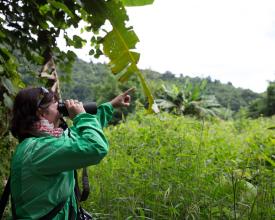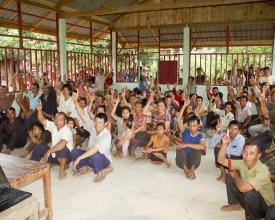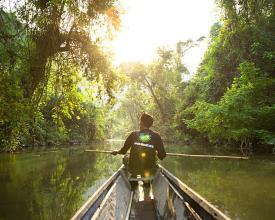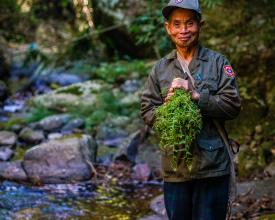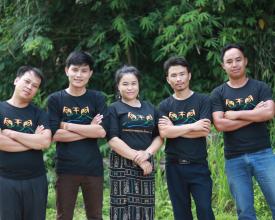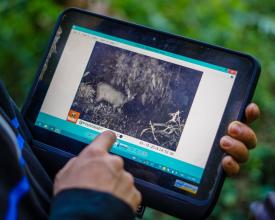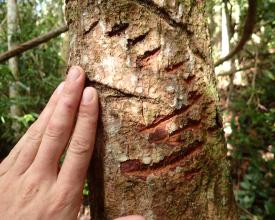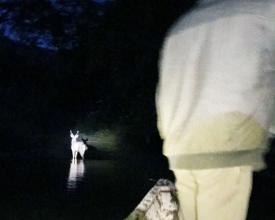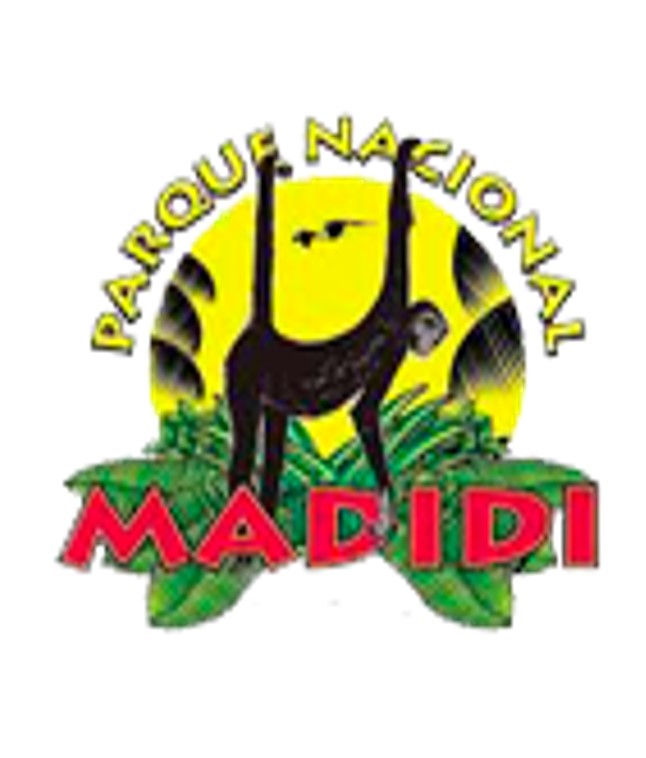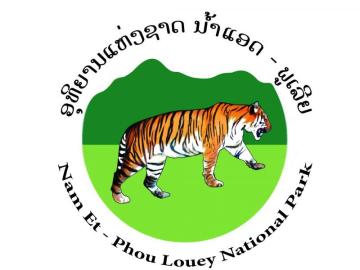Ecoturismo para la conservación de la fauna salvaje en el Parque Nacional de Nam Et-Phou Louey (RDP Lao)
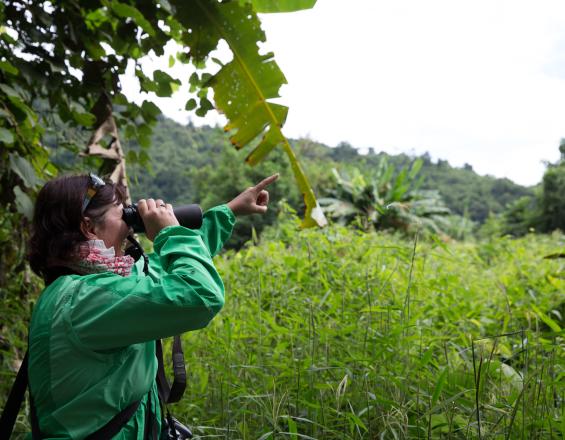
El Parque Nacional Nam Et-Phou Louey (PN NEPL) es una de las zonas protegidas más extensas y con mayor biodiversidad de Laos. Al mismo tiempo, más de 30.000 personas de 91 aldeas, representantes de múltiples grupos étnicos situados en algunos de los distritos más pobres del país, viven dentro del PN NEPL o en sus inmediaciones.
Para ofrecer oportunidades de subsistencia a la población local y salvaguardar la biodiversidad y los ecosistemas del parque nacional, de los que dependen las comunidades, el PN NEPL inició en 2010 un programa de ecoturismo de vida salvaje.
Los ecotours del PN NEPL se han diseñado de forma que creen un vínculo directo entre conservación y turismo, de modo que el dinero generado por los visitantes actúe como incentivo para que las comunidades locales que trabajan en el turismo y viven en los alrededores de la zona ecoturística protejan la vida salvaje. Esto se consigue tanto mediante el empleo directo en los grupos proveedores de servicios ecoturísticos como mediante un sistema más amplio de incentivos económicos a las comunidades circundantes en función de sus esfuerzos de conservación.
Contexto
Défis à relever
El PN NEPL se enfrenta a numerosas amenazas y desafíos. Los principales impulsores directos de la pérdida de hábitat y la caza furtiva en el PN NEPL son:
- La extracción insostenible y/o ilegal de madera,
- Desarrollo insostenible y/o ilegal de infraestructuras (carreteras, energía hidroeléctrica, minería, etc.),
- la demanda local y regional de carne de animales silvestres y partes de animales raros, y
- Elevada pobreza.
Estas amenazas, unidas a la continua presión del crecimiento económico, aumentan aún más el peso sobre la vida salvaje y el hábitat natural del PN NEPL.
Ubicación
Procesar
Resumen del proceso
El (1) "Fondo de beneficios ecoturísticos" del PN NEPL con las comunidades que rodean la zona de ecoturismo es el pilar clave para crear un vínculo directo entre el ecoturismo y la conservación de la vida salvaje. Los (2) "Contratos de proveedores de servicios ecoturísticos " garantizan la transparencia y la equidad en el proceso de selección de proveedores de servicios ecoturísticos y la distribución de los ingresos del turismo en el pueblo. El (3) "Desarrollo de la capacidad local y sensibilización" es esencial para desarrollar un equipo fuerte a largo plazo y garantizar el apoyo de los responsables de la toma de decisiones y del público. Independientemente de ello, (4) la presencia de "fuerzas del orden" es esencial en las zonas de turismo de fauna salvaje, ya que el simple desarrollo del turismo de fauna salvaje no conlleva automáticamente una reducción de las amenazas o una mejora de los niveles de protección de la fauna salvaje. Para garantizar una mayor afluencia de visitantes, (5) el "marketing y la colaboración con el sector privado del turismo" son esenciales para los productos turísticos situados en zonas remotas. Por último, (6) "Seguimiento y gestión adaptativa " es indispensable para garantizar la sostenibilidad del proyecto y unos resultados socioeconómicos y de conservación positivos.
Bloques de construcción
Fondo de Beneficios Ecoturísticos
Para crear un amplio apoyo comunitario a la conservación, el PN NEPL introdujo el Fondo de Beneficios Ecoturísticos (EBF). A través del EBF, el PN NEPL no sólo entrega a los pueblos de los alrededores de la zona ecoturística una cantidad fija de dinero por cada turista que realiza la excursión, sino que se proporciona una cantidad adicional en función del número y el tipo de vida salvaje que encuentren los visitantes en la excursión. Para fomentar los esfuerzos de conservación, se ofrecen mayores incentivos por el avistamiento de especies con mayor importancia para la conservación.
Aunque el programa de ecoturismo del PN NEPL ofrece oportunidades de ingresos turísticos directos a los miembros de sólo alrededor del 40% de los hogares de 4 aldeas, en total 26 aldeas reciben anualmente beneficios económicos del programa de turismo del PN NEPL en función de sus esfuerzos de conservación.
Factores facilitadores
- Acuerdo del Fondo de Beneficios Ecoturísticos (EBF),
- Reuniones anuales de divulgación del ecoturismo con todos los pueblos participantes,
- Incentivos financieros basados en los esfuerzos de conservación de la comunidad,
- Objetivos de conservación vinculados a incentivos financieros para las comunidades.
Lección aprendida
- El vínculo entre los esfuerzos de conservación de la comunidad y los ingresos del turismo debe ser claro y directo: la simple mejora de los ingresos de los aldeanos puede no conducir a una mejora de la conservación; sin embargo, la reducción de la pobreza es un paso esencial para mejorar la utilización de los recursos naturales y los esfuerzos de conservación a largo plazo.
- Además de los incentivos positivos para la conservación en el diseño de la estrategia de EBF, el acuerdo de distribución de beneficios también debe esbozar los desincentivos para el incumplimiento de las normas. Por ejemplo, si se descubre a alguien de las aldeas ecoturísticas incumpliendo el acuerdo, se reducirá el EBF anual de la aldea del individuo en cuestión.
- Para garantizar la equidad en el reparto del EBF, éste se calcula y distribuye anualmente a todas las aldeas ecoturísticas en función del número de hogares y se utiliza para apoyar actividades de desarrollo a pequeña escala elegidas por cada aldea mediante votación popular, en lugar de distribuir pagos en efectivo.
Contratos de proveedores de servicios ecoturísticos
Un proceso de participación inclusivo, justo y transparente y unos mecanismos de reparto de los beneficios del turismo son fundamentales para crear y mantener la confianza de las comunidades locales.
Para repartir equitativamente los beneficios del turismo en el pueblo, es importante establecer normas claras y justas para la selección del proveedor de servicios ecoturísticos. En el caso del programa de ecoturismo del PN NEPL, los elementos clave son:
- 1 persona por hogar. Sólo un miembro de cada hogar puede pertenecer a un único grupo de servicios,
- En el proceso de selección se da prioridad a las familias pobres y desfavorecidas,
- No se infringe la normativa de NEPL NP durante un mínimo de 2 años.
Para garantizar un proceso de selección de proveedores de servicios ecoturísticos transparente y equitativo, un comité de múltiples partes interesadas vota a los candidatos voluntarios. El comité está formado por los siguientes miembros: (1) el jefe de ecoturismo del pueblo, (2) los proveedores de servicios ecoturísticos existentes y (3) el personal del parque nacional que trabaja en estrecha colaboración con las comunidades.
Factores facilitadores
- Contratos de proveedores de servicios ecoturísticos
- Proceso de selección transparente y equitativo
- Aplicación estricta de los contratos
- Proceso de modificación de contratos participativo y transparente
Lección aprendida
El trabajo y las normas del proveedor de servicios de ecoturismo deben presentarse claramente a la comunidad y debe haber oportunidad para preguntas/respuestas y negociación. Es posible que se produzcan modificaciones extraordinarias, que sólo deberán confirmarse una vez aprobadas por la comunidad.
Capacitación y sensibilización
El programa de ecoturismo del PN NEPL crea directa e indirectamente oportunidades de desarrollo de habilidades y capacidades y de concienciación para los siguientes grupos: (1) el propio equipo de ecoturismo del PN NEPL (2) las comunidades ecoturísticas y los proveedores de servicios (3) los visitantes, los TO y los homólogos gubernamentales.
Cuando se inició el programa del PN NEPL en 2010, el turismo era casi inexistente en la región. Al ofrecer una oportunidad de aprender a los lugareños y contratar a consultores de turismo como apoyo, el personal de ecoturismo del PN NEPL se ha convertido en algunos de los profesionales del ecoturismo con más experiencia del país. La mayor parte de este personal procede de las aldeas del PN NEPL y pertenece a familias de antiguos cazadores o incluso ellos mismos fueron cazadores. Al trabajar con el PN NEPL, el personal ha aprendido sobre la importancia de la conservación y hoy son reconocidos funcionarios del ecoturismo y defensores de la conservación. Algunos de ellos han ascendido a puestos clave de gestión y asesoramiento en el PN NEPL.
El equipo de ecoturismo del PN NEPL crea y coordina ahora oportunidades de formación en ecoturismo y campañas de divulgación. Además, el programa de ecoturismo del PN NEPL tiene un poder de concienciación nada desdeñable que beneficia a todos los visitantes, así como a las OT y a los homólogos gubernamentales.
Factores facilitadores
- Formación, talleres y viajes de estudio
- Estrecha colaboración con los principales responsables de la toma de decisiones
Lección aprendida
- Es esencial colaborar estrechamente con la comunidad local y los organismos gubernamentales durante el desarrollo y la gestión de los proyectos.
- Durante el inicio del programa de ecoturismo, la contratación de recursos humanos locales cualificados fue un reto, por lo que se seleccionó personal de otras provincias. Sin embargo, debido a la remota ubicación del PN NEPL, este personal se trasladó al poco tiempo. La contratación de personal menos cualificado, pero local y motivado, y la provisión de las aptitudes y oportunidades de capacitación necesarias han dado mejores resultados y un mayor nivel de compromiso.
Cumplimiento de la ley
En las dos zonas de ecoturismo del PN NEPL hay dos puestos de guardabosques. Los equipos encargados de hacer cumplir la ley en la zona de ecoturismo detienen las actividades ilegales, protegen las infraestructuras turísticas y aportan datos al cálculo del Fondo de Beneficios Ecoturísticos. Además, los ecotours del PN NEPL aportan beneficios al programa de aplicación de la ley del PN NEPL a través de las siguientes actividades: (1) presencia regular en el PN NEPL, (2) identificación de actividades ilegales, (3) comunicación de la normativa del área protegida a las comunidades y los visitantes.
Factores facilitadores
- Equipos móviles de guardabosques
- Estrategia policial, recursos financieros y humanos
- Fiscalía
Lección aprendida
- Una presencia activa de las fuerzas del orden es esencial en las zonas de turismo de vida silvestre, mientras que el simple desarrollo del turismo de vida silvestre no conduce automáticamente a una reducción de las amenazas o a una mejora de los niveles de protección de la vida silvestre.
- Debido a la limitación de los recursos financieros y humanos, la presencia de las fuerzas del orden puede no estar distribuida por igual en toda la zona de ecoturismo. Por lo tanto, puede ser necesario incorporar mecanismos de seguimiento adicionales que puedan ser evaluados por igual, por ejemplo, el seguimiento de los esfuerzos de la comunidad en lo que respecta a la invasión de tierras mediante la comparación del plan de uso de la tierra y las imágenes de satélite.
Marketing y colaboración con el sector privado del turismo
El PN NEPL está situado en una de las zonas más remotas del país, lejos de los principales centros turísticos y aeropuertos. Para atraer visitantes a esta remota zona del país, es esencial un marketing claro, una excelente reputación y la colaboración con las OT y las agencias de viajes.
Factores facilitadores
- Estrecha colaboración con el sector privado (TO, agencias de viajes, hoteles, etc.),
- Recursos de marketing actualizados, atractivos y completos,
- Exposición en los medios de comunicación,
- Premios.
Lección aprendida
- La estrecha colaboración con las OT y las Agencias de Viajes es esencial cuando el destino se encuentra en una zona remota del país. Además de organizar el transporte de los visitantes, las OT y las agencias de viajes pueden ofrecer al destino fantásticas oportunidades de marketing y visibilidad internacional.
- Los antiguos clientes son excelentes agentes de marketing, especialmente para el turismo nacional.
- Los premios y la exposición internacional positiva mejoran la buena colaboración con los homólogos gubernamentales.
Recursos
Seguimiento y gestión adaptativa
El seguimiento regular del programa de ecoturismo del PN NEPL es esencial para garantizar los objetivos de conservación, así como la continua satisfacción de los visitantes y, por tanto, la sostenibilidad general del proyecto. El programa de ecoturismo del PN NEPL supervisa la siguiente información:
- Elmonitoreo de la vida silvestre se adapta al área de ecoturismo e incorpora todas o algunas de las siguientes técnicas: Captura con cámara, Registro GPS de todas las observaciones directas/indirectas, Registro de especies de observaciones directas.
- Los datos financieros se introducen en el sistema por cada excursión y se analizan mensual y anualmente.
- Losdatos sobre la opinión de los visitantes se recogen después de cada visita y permiten identificar y mejorar los servicios de las visitas en el momento más oportuno, así como considerar nuevas ideas y necesidades de mejora.
- Los datosde llegada y perfil de los visitantes se recogen de todos los visitantes en cada visita y permiten identificar las tendencias y el perfil de los visitantes y, por tanto, comprender y comunicar mejor al mercado, así como identificar nuevas oportunidades.
Factores facilitadores
- Formularios de recogida de datos
- Sistemas de seguimiento de la fauna (observaciones directas, cámaras trampa, etc.)
- SMART (herramienta de seguimiento e información espacial)
Lección aprendida
- Los sistemas de recogida de datos deben ser fáciles de usar y sencillos,
- Los datos ecoturísticos recopilados pueden ser útiles para la gestión del Parque Nacional, especialmente los datos sobre la fauna salvaje y las observaciones sobre el cumplimiento de la ley.
Impactos
- Conservación de la vida salvaje: Importantes beneficios para la conservación gracias a la disminución de las amenazas y a un aumento cuantificable de los avistamientos de animales salvajes. La media de avistamientos de animales salvajes en la excursión Nam Nern Night Safari ha pasado de 4 animales en 2010 a una media de 11 animales por excursión en 2021.
- Medios de subsistencia: Oportunidades adicionales de sustento para más de 150 hogares en 4 aldeas. El 40% de los proveedores de servicios ecoturísticos son mujeres y el 30% son menores de 30 años.
- Amplio reparto de beneficios. 26 aldeas, que representan a más de 2.000 hogares, reciben incentivos económicos en función de la fauna y flora vistas por los visitantes en las excursiones ecoturísticas del PN NEPL, lo que representa casi el 30% de todas las aldeas del PN NEPL, y en su mayoría pertenecen a las minorías étnicas khmu y hmong. Además, el programa de ecoturismo del PN NEPL genera beneficios económicos para el Parque Nacional, los empresarios turísticos y el Gobierno.
- Educación: Oportunidades continuas de educación y desarrollo de habilidades para múltiples grupos de interesados (comunidades, visitantes, gobierno), así como un entorno educativo positivo para el personal de ecoturismo del PN NEPL.
- Exposicióninternacional positiva: A través de varios premios y visibilidad en los principales medios de comunicación, el programa de ecoturismo del PN NEPL crea una exposición internacional positiva para el país.
Beneficiarios
- Más de 150 hogares proveedores de servicios de ecoturismo,
- 26 comunidades alrededor de los lugares de ecoturismo del PN NEPL,
- Parque Nacional Nam Et-Phou Louey,
- Gobierno,
- Empresarios (hoteles, restaurantes, tiendas, agencias de viajes).
Objetivos de Desarrollo Sostenible
Historia
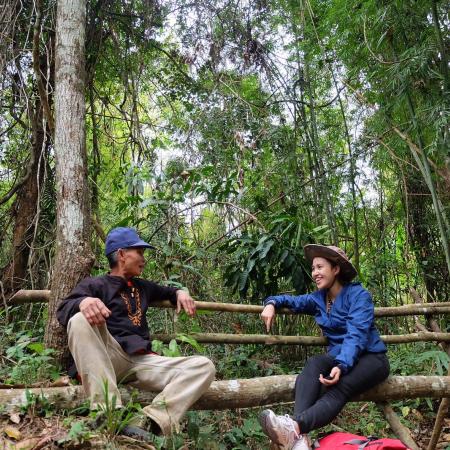
Tradicionalmente, la fauna salvaje es valiosa para las comunidades del PN NEPL, pero sólo una vez capturado o sacrificado el animal, ya que entonces puede venderse para obtener ingresos adicionales para el hogar o puede consumirse para alimentar a la familia. Con el aumento de la demanda nacional y regional de carne de animales silvestres y partes de animales raros y el crecimiento de la población humana, esta práctica ya no es sostenible.
Para superar este reto, el PN NEPL introdujo el ecoturismo como fuente de ingresos alternativa a la caza. Sin embargo, el turismo, sobre todo en zonas remotas de escaso turismo, tiene sus limitaciones, ya que no todos los miembros de la comunidad pueden emplearse en el turismo o en los sectores relacionados.
Para crear un amplio apoyo comunitario a la conservación y compartir los ingresos del turismo, el PN NEPL introdujo el Fondo de Beneficios Ecoturísticos (EBF). A través del EBF, el PN NEPL no sólo entrega a las aldeas que rodean la zona de ecoturismo una cantidad fija de dinero por cada turista que realiza la excursión, sino que se proporciona una cantidad adicional en función del número y el tipo de fauna salvaje que encuentren los visitantes en la excursión. Para fomentar los esfuerzos de conservación, se ofrecen mayores incentivos por el avistamiento de especies con mayor importancia para la conservación.
Al principio, cuando el PN NEPL inició el programa de ecoturismo en 2010, muchos proveedores de servicios ecoturísticos intentaron disfrutar de ambas oportunidades de ingresos: el ecoturismo y la caza. En consecuencia, los respectivos individuos recibieron una advertencia o se rescindió su contrato, y se redujo el EBF anual de su aldea. Esta fue una valiosa lección aprendida para otros.
Con el aumento de la llegada de visitantes, crecieron también los ingresos de la comunidad procedentes de los servicios ecoturísticos y del EBF. En consecuencia, más hogares se interesaron por el ecoturismo y se mostraron dispuestos a cumplir la normativa del parque nacional. Los antiguos miembros de los hogares que infringían la normativa podían volver a solicitar los puestos de ecoturismo si su historial estaba limpio desde hacía más de 2 años. Ahora, 10 años después, más de 150 familias de 4 pueblos trabajan como proveedores de servicios ecoturísticos (observadores de la fauna, barqueros, cocineros, productores de recuerdos, etc.) y 26 pueblos de los alrededores reciben beneficios económicos a través del EBF, lo que representa casi el 30% de todos los pueblos del PN NEPL.

